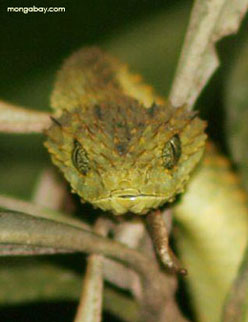Venomous snakes key to human evolution says new theory
UC Davis
July 21, 2006
The ability to spot venomous snakes may have played a major role in the evolution of monkeys, apes and humans, according to a new hypothesis by Lynne Isbell, professor of anthropology at UC Davis. The work is published in the July issue of the Journal of Human Evolution.
Primates have good vision, enlarged brains, and grasping hands and feet, and use their vision to guide reaching and grasping. Scientists have thought that these characteristics evolved together as early primates used their hands and eyes to grab insects and other small prey, or to handle and examine fruit and other foods.
Isbell suggests instead that primates developed good close-up eyesight to avoid a dangerous predator — the snake.
“A snake is the only predator you really need to see close up. If it’s a long way away it’s not dangerous,” Isbell said.

Green bush viper in Gabon. Photo by Rhett A. Butler. |
Fossils and DNA evidence show that snakes were likely the first serious predators of modern mammals, which evolved about 100 million years ago. Fossils of snakes with mouths big enough to eat those mammals appear at about the same time. Other animals that could have eaten our ancestors, such as big cats, and hawks and eagles, evolved much later.
Venomous snakes evolved about 60 million years ago, raising the stakes and forcing primates to get better at detecting them.
“There’s an evolutionary arms race between the predators and prey. Primates get better at spotting and avoiding snakes, so the snakes get better at concealment, or more venomous, and the primates respond,” Isbell said.
Some primate groups less threatened by snakes show fewer signs of evolutionary pressure to evolve better vision. For example, the lemurs of Madagascar do not have any venomous snakes in their environment, and in evolutionary terms “have stayed where they are,” Isbell said. In South America, monkeys arrived millions of years before venomous snakes, and show less specialization in their visual system compared with Old World monkeys and apes, which all have good vision, including color.
Having evolved for one purpose, a good eye for color, detail and movement later became useful for other purposes, such as social interactions in groups.
Isbell is currently working on a book about primate origins, including her snake hypothesis.
This is a modified news release from UC Davis







